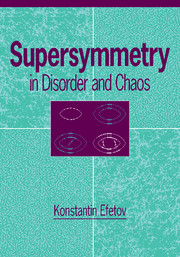Book contents
- Frontmatter
- Contents
- Preface
- Acknowledgments
- 1 Introduction
- 2 Supermathematics
- 3 Diffusion modes
- 4 Nonlinear supermatrix σ-model
- 5 Perturbation theory and renormalization group
- 6 Energy level statistics
- 7 Quantum size effects in small metal particles
- 8 Persistent currents in mesoscopic rings
- 9 Transport through mesoscopic devices
- 10 Universal parametric correlations
- 11 Localization in systems with one-dimensional geometry
- 12 Anderson metal–insulator transition
- 13 Disorder in two dimensions
- 14 Afterword
- Appendix 1 Calculation of the Jacobian
- Appendix 2 Magnetic field parametrization
- Appendix 3 Density–density correlation function at k = 0
- Appendix 4 Effective medium approximation as a saddle point
- References
- Author index
- Subject index
11 - Localization in systems with one-dimensional geometry
Published online by Cambridge University Press: 10 November 2010
- Frontmatter
- Contents
- Preface
- Acknowledgments
- 1 Introduction
- 2 Supermathematics
- 3 Diffusion modes
- 4 Nonlinear supermatrix σ-model
- 5 Perturbation theory and renormalization group
- 6 Energy level statistics
- 7 Quantum size effects in small metal particles
- 8 Persistent currents in mesoscopic rings
- 9 Transport through mesoscopic devices
- 10 Universal parametric correlations
- 11 Localization in systems with one-dimensional geometry
- 12 Anderson metal–insulator transition
- 13 Disorder in two dimensions
- 14 Afterword
- Appendix 1 Calculation of the Jacobian
- Appendix 2 Magnetic field parametrization
- Appendix 3 Density–density correlation function at k = 0
- Appendix 4 Effective medium approximation as a saddle point
- References
- Author index
- Subject index
Summary
One-dimensional σ-model
One-dimensional σ-model for disorder problems
Most of the results of Chapters 6–10 have been obtained by using the zero-dimensional (0D) σ-model and we have seen that many rather different physical problems can be treated within this approximation successfully. Nevertheless, for some problems that can be described by the supermatrix σ-model the 0D version is not applicable. For example, localization in two-dimensional disordered metals was discussed in Chapter 5 and it had to be described by the two-dimensional (2D) σ-model. The problem is rather complicated and the solution presented there is not complete.
There are many problems of disordered metals and quantum chaos that can be reduced to a study of the one-dimensional (ID) σ-model. In contrast to those with higher dimensions, the ID σ-model can be studied exactly by the transfer matrix technique, and very often it is possible to get explicit final results although the calculations are somewhat more difficult than in the 0D case. By now, the procedure of computation of different correlation functions with the ID σ-model is well worked out, but before presenting it in detail let us discuss physical problems that can be treated in this way.
It is natural to suppose that the ID σ-model describes one-dimensional disordered metals. However, when using the term one-dimensional one should distinguish between truly one-dimensional chains and microscopically three-dimensional metals with a one-dimensional geometry of the sample.
- Type
- Chapter
- Information
- Supersymmetry in Disorder and Chaos , pp. 274 - 317Publisher: Cambridge University PressPrint publication year: 1996



